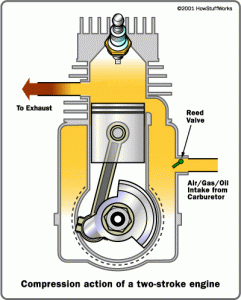The Anatomy of the Two-Stroke Engine: Part One
 Four-stroke engines are ubiquitous in automobile manufacturing and while you may consider the two-stroke engine an antiquated instrument, it still has myriad uses. From yard tools and dirt bikes to RC toys and outboard motors, the two-stroke engine is still utilized in many smaller vehicles and implements. Before we start to overview the inner workings of the two-stroke engine, let’s highlight a few of its main advantages over its four-stroke counterpart:
Four-stroke engines are ubiquitous in automobile manufacturing and while you may consider the two-stroke engine an antiquated instrument, it still has myriad uses. From yard tools and dirt bikes to RC toys and outboard motors, the two-stroke engine is still utilized in many smaller vehicles and implements. Before we start to overview the inner workings of the two-stroke engine, let’s highlight a few of its main advantages over its four-stroke counterpart:
~Simple construction: the absence of valves lowers the unit’s weight and minimizes the opportunity for breakdowns.
~More power: since two-stroke engines for every revolution, as opposed to every other revolution, they can generate more power than a four-stroke engine.
~Work in any direction: if you try to operate a four-stroke engine upside-down or sideways, you may encounter problems with oil flow. The gasoline and outboard motor oil are combined in a two-stroke engine, eliminating this problem.

